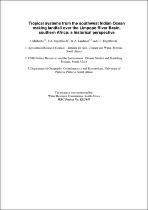 ResearchSpace
ResearchSpace
Tropical systems from the southwest Indian Ocean making landfall over the Limpopo River Basin, southern Africa: a historical perspective
JavaScript is disabled for your browser. Some features of this site may not work without it.
- ResearchSpace
- →
- Research Publications/Outputs
- →
- Journal Articles
- →
- View Item
| dc.contributor.author |
Malherbe, Johan

|
|
| dc.contributor.author |
Engelbrecht, FA

|
|
| dc.contributor.author |
Landman, WA

|
|
| dc.contributor.author |
Engelbrecht, CJ

|
|
| dc.date.accessioned | 2012-07-09T13:18:07Z | |
| dc.date.available | 2012-07-09T13:18:07Z | |
| dc.date.issued | 2011-03 | |
| dc.identifier.citation | Malherbe, J, Engelbrecht, FA, Landman, WA and Engelbrecht, CJ. 2011. Tropical systems from the southwest Indian Ocean making landfall over the Limpopo River Basin, southern Africa: a historical perspective. International Journal of Climatology, vol. 32(7), pp 1018-1032 | en_US |
| dc.identifier.issn | 0899-8418 | |
| dc.identifier.issn | 1097-0088 | |
| dc.identifier.uri | http://onlinelibrary.wiley.com/doi/10.1002/joc.2320/abstract | |
| dc.identifier.uri | http://hdl.handle.net/10204/5988 | |
| dc.description | Copyright: 2011 Wiley. This is the post-print version of the work. The definitive version is published in the International Journal of Climatology, vol. 32(7), pp 1018-1032 | en_US |
| dc.description.abstract | The study provides perspective on the contribution of landfalling tropical systems (cyclones, depressions, storms and lows) from the southwest Indian Ocean (SWIO) towards rainfall over the eastern interior of southern Africa, over the period 1948–2008. Although these systems contribute to <10% of the annual rainfall occurring over the region, their relative contribution to local and widespread heavy rainfall events is shown to be highly significant. About 50% of widespread heavy rainfall events over northeastern South Africa are caused by landfalling tropical systems. Fourier analysis performed on the time series of rainfall occurring over northeastern South Africa in association with these systems reveals the existence of a quasi-18-year cycle. The cycle coincides with the well-known quasi-18-year Dyer–Tyson cycle in rainfall over the summer rainfall region of South Africa. These results suggest that atmospheric and surface conditions leading to wet phases of the Dyer–Tyson cycle also favour the landfall and subsequent westward movement of tropical systems from the SWIO over southern Africa – and their eventual contribution to rainfall over northeastern South Africa and southern Zimbabwe. | en_US |
| dc.language.iso | en | en_US |
| dc.publisher | Wiley | en_US |
| dc.relation.ispartofseries | Workflow;8575 | |
| dc.subject | Tropical cyclone | en_US |
| dc.subject | Landfall | en_US |
| dc.subject | Rainfall cyclicity | en_US |
| dc.subject | Tropical systems | en_US |
| dc.subject | Southern Africa tropical systems | en_US |
| dc.subject | Fourier analysis | en_US |
| dc.subject | Closed-low tracking | en_US |
| dc.title | Tropical systems from the southwest Indian Ocean making landfall over the Limpopo River Basin, southern Africa: a historical perspective | en_US |
| dc.type | Article | en_US |
| dc.identifier.apacitation | Malherbe, J., Engelbrecht, F., Landman, W., & Engelbrecht, C. (2011). Tropical systems from the southwest Indian Ocean making landfall over the Limpopo River Basin, southern Africa: a historical perspective. http://hdl.handle.net/10204/5988 | en_ZA |
| dc.identifier.chicagocitation | Malherbe, Johan, FA Engelbrecht, WA Landman, and CJ Engelbrecht "Tropical systems from the southwest Indian Ocean making landfall over the Limpopo River Basin, southern Africa: a historical perspective." (2011) http://hdl.handle.net/10204/5988 | en_ZA |
| dc.identifier.vancouvercitation | Malherbe J, Engelbrecht F, Landman W, Engelbrecht C. Tropical systems from the southwest Indian Ocean making landfall over the Limpopo River Basin, southern Africa: a historical perspective. 2011; http://hdl.handle.net/10204/5988. | en_ZA |
| dc.identifier.ris | TY - Article AU - Malherbe, Johan AU - Engelbrecht, FA AU - Landman, WA AU - Engelbrecht, CJ AB - The study provides perspective on the contribution of landfalling tropical systems (cyclones, depressions, storms and lows) from the southwest Indian Ocean (SWIO) towards rainfall over the eastern interior of southern Africa, over the period 1948–2008. Although these systems contribute to <10% of the annual rainfall occurring over the region, their relative contribution to local and widespread heavy rainfall events is shown to be highly significant. About 50% of widespread heavy rainfall events over northeastern South Africa are caused by landfalling tropical systems. Fourier analysis performed on the time series of rainfall occurring over northeastern South Africa in association with these systems reveals the existence of a quasi-18-year cycle. The cycle coincides with the well-known quasi-18-year Dyer–Tyson cycle in rainfall over the summer rainfall region of South Africa. These results suggest that atmospheric and surface conditions leading to wet phases of the Dyer–Tyson cycle also favour the landfall and subsequent westward movement of tropical systems from the SWIO over southern Africa – and their eventual contribution to rainfall over northeastern South Africa and southern Zimbabwe. DA - 2011-03 DB - ResearchSpace DP - CSIR KW - Tropical cyclone KW - Landfall KW - Rainfall cyclicity KW - Tropical systems KW - Southern Africa tropical systems KW - Fourier analysis KW - Closed-low tracking LK - https://researchspace.csir.co.za PY - 2011 SM - 0899-8418 SM - 1097-0088 T1 - Tropical systems from the southwest Indian Ocean making landfall over the Limpopo River Basin, southern Africa: a historical perspective TI - Tropical systems from the southwest Indian Ocean making landfall over the Limpopo River Basin, southern Africa: a historical perspective UR - http://hdl.handle.net/10204/5988 ER - | en_ZA |





